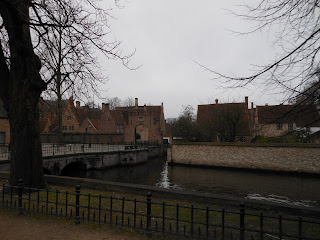After Brussels, we went and spent a couple of days in Brugge, Belgium. Brugge is the capital and largest city of the province of West Flanders in the Flemish Region of Belgium. It is located in the northwest part of the country. The historic city center is World Heritage Site. Brugge was first mentioned in about 840 A.D. The name Brugge means bridge.
Brugge is a medieval city that has most of its medieval architecture intact. Many of its medieval buildings are exceptional. The Church of our Lady, whose brick spire reaches 401 ft, makes it one of the world's highest brick towers/buildings. The sculpture Madonna and Child, which can be seen in the transept, is believed to be Michelangelo's only sculpture to have left Italy within his lifetime. Brugge's most famous landmark is its 13th-century belfry, housing a municipal carillon comprising 48 bells.
Brugge got its city charter in 1128 and new walls and canals were built. Since about 1050, gradual silting had caused the city to lose its direct access to the sea. A storm in 1134, however, re-established this access, through the creation of a natural channel. The new sea arm stretched all the way to Damme, a city that became the commercial outpost for Brugge. The 12th through the 15th centuries were the Golden Age for the city. It was the major market/trade center between western Europe and England/Scotland. The wool market and weaving became a major industry. Brugge was included in the circuit of the Flemish cloth fairs at the beginning of the 13th century. Wool from England and Scotland, grain from Normandy, wines from France, along with spices from the Mediterranean flowed through the merchant shops.
The flood of capital during the Golden Age gave rise to capital markets and banking. The Bourse (probably the first stock exchange in the world) opened in 1309 and developed into the most sophisticated money market of the Low Countries in the 14th century.
In the 15th century, Philip the Good, duke of Burgundy, set up court in Brugge, attracting a number of artists, bankers, and other prominent personalities from all over Europe. The weavers and spinners of Brugge were thought to be the best in the world, and the population of Brugge grew to 200,000 inhabitants at this time. The new Flemish-school, oil-painting techniques gained world renown. The first book in English ever printed was published in Brugge. The Germans used it for their U-boats in World War I.
Brugge is a medieval city that has most of its medieval architecture intact. Many of its medieval buildings are exceptional. The Church of our Lady, whose brick spire reaches 401 ft, makes it one of the world's highest brick towers/buildings. The sculpture Madonna and Child, which can be seen in the transept, is believed to be Michelangelo's only sculpture to have left Italy within his lifetime. Brugge's most famous landmark is its 13th-century belfry, housing a municipal carillon comprising 48 bells.
Brugge got its city charter in 1128 and new walls and canals were built. Since about 1050, gradual silting had caused the city to lose its direct access to the sea. A storm in 1134, however, re-established this access, through the creation of a natural channel. The new sea arm stretched all the way to Damme, a city that became the commercial outpost for Brugge. The 12th through the 15th centuries were the Golden Age for the city. It was the major market/trade center between western Europe and England/Scotland. The wool market and weaving became a major industry. Brugge was included in the circuit of the Flemish cloth fairs at the beginning of the 13th century. Wool from England and Scotland, grain from Normandy, wines from France, along with spices from the Mediterranean flowed through the merchant shops.
The flood of capital during the Golden Age gave rise to capital markets and banking. The Bourse (probably the first stock exchange in the world) opened in 1309 and developed into the most sophisticated money market of the Low Countries in the 14th century.
In the 15th century, Philip the Good, duke of Burgundy, set up court in Brugge, attracting a number of artists, bankers, and other prominent personalities from all over Europe. The weavers and spinners of Brugge were thought to be the best in the world, and the population of Brugge grew to 200,000 inhabitants at this time. The new Flemish-school, oil-painting techniques gained world renown. The first book in English ever printed was published in Brugge. The Germans used it for their U-boats in World War I.
Canal and street in Brugge
Brugge Architecture
Plenty of photo opportunities
A smaller market square
Christmas Tree in the market
Street with shops
Market Square
Market Square
Government Building on Market Square
Great Moustache
Belgium Chocolate
Decisions, decisions.....the waffles are excellent
Brugge shops on the Market Square
Old bridge over a canal
Relaxing
Shops at night
Canals and buildings at night
Brugge canal and medieval buildings
The Bell Tower
The bell tower machinery
Some of the 48 bells in the tower
View from the Bell Tower
View from the Bell Tower
More scenery in Brugge
We took a horse drawn carriage ride
Mel talking to our horse
A ride in the carriage
Horse carriages on a street in Brugge
Bridge with Swans
Beautiful architecture
Looking in the street shops
































No comments:
Post a Comment